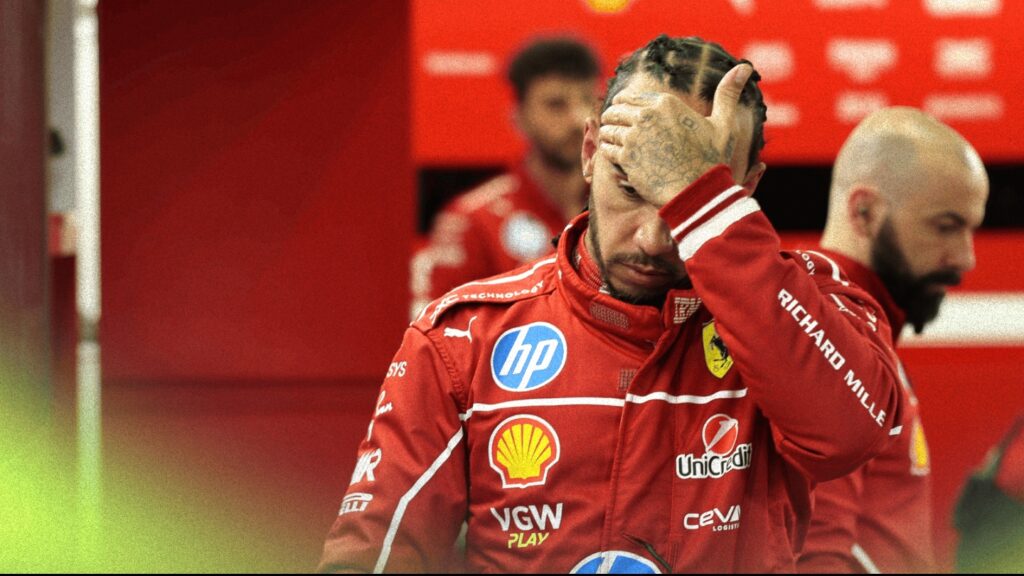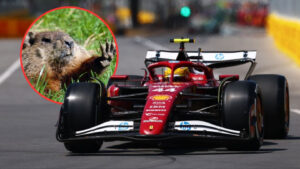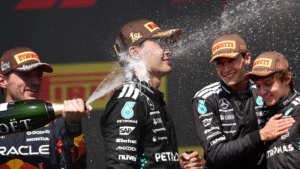Hamilton’s Hidden Cruelty: Emotional Aftermath of Groundhog Collision at Canadian GP

Formula 1 is a sport that thrives on precision, speed, and control. But sometimes, it throws up moments that are raw, unexpected, and deeply human. At the 2025 Canadian Grand Prix, one such moment unfolded — not involving a crash between drivers or a mechanical failure, but something that cut far deeper for seven-time world champion Lewis Hamilton.
On Lap 13 of the race at Circuit Gilles Villeneuve, Hamilton unintentionally struck a groundhog that had wandered onto the track. What followed wasn’t just damage to his Ferrari’s underfloor — it was an emotional ripple that highlighted how even the fastest man on track can be brought to a standstill by grief.
❗ The Incident: A Sudden, Unseen Collision
Montreal’s island circuit is no stranger to wildlife. Groundhogs, in particular, have become a peculiar part of the track’s identity. But on that Sunday afternoon, it wasn’t a quirky sideshow — it was a heart-wrenching moment.

Hamilton had no time to react. As he pushed through the race in pursuit of the leading pack, the small animal darted across the circuit. The impact was immediate and unavoidable.
🗣️ Lewis Hamilton
“I was feeling good until I heard I’d hit a groundhog… That’s devastating. I love animals and I’m so sad about it. That’s horrible.”
The contact, though not immediately visible to viewers, had significant consequences on both emotional and technical fronts.
🛠️ Technical Consequences: The Car Was Never the Same
Post-race analysis from Ferrari engineers revealed that the impact wasn’t superficial. The underside of Hamilton’s car had sustained notable damage — particularly to the floor and aerodynamic elements on the right-hand side.
This had a measurable effect on performance:
- Damage to aero vanes and floor edge
- Estimated 20 points of downforce lost
- Lap time degradation of ~0.5 seconds per lap
🗣️ Fred Vasseur, Ferrari Team Principal
“We had a big kiss with a marmot, and this damaged the front part of the floor and the turning vanes. It impacted performance a lot.”
Hamilton struggled with rear-end grip and braking instability for the remainder of the race. Though he bravely fought back and finished sixth, the incident likely cost him a shot at the podium.
💔 Emotional Toll: A Champion’s Vulnerability
For Hamilton, the impact wasn’t just aerodynamic — it was personal.
Known for his deep commitment to animal rights and plant-based living, the moment left him visibly shaken. After the race, while other drivers spoke about tyre strategy and overtakes, Hamilton reflected quietly on the life lost in a moment of speed.
🗣️ Lewis Hamilton
“It’s a really weird experience. I’ve never hit or killed an animal during a race in my entire career.”

This deeply personal statement resonated across social media and within the paddock. For many fans, it was a reminder that beneath the helmets and high-tech machinery, F1 drivers are still human.
🐾 Wildlife at Circuit Gilles Villeneuve: A History
The Montreal track is famous for its wildlife. Surrounded by the St. Lawrence River and nestled within Parc Jean-Drapeau, it’s not uncommon for groundhogs to appear during race weekends.
Past incidents include:
| Year | Driver | Incident Description |
|---|---|---|
| 2007 | Anthony Davidson | Collided with groundhog during warm-up |
| 2018 | Romain Grosjean | Missed groundhog, but lost control nearby |
| 2025 | Lewis Hamilton | Hit groundhog on Lap 13, floor damaged |
Despite multiple interventions by organizers over the years, the presence of animals remains a recurring issue — one that is now sparking renewed debate about track safety and wildlife protection.
🔧 Bigger Picture for Ferrari: More Than Just Bad Luck
While the emotional weight of the incident was significant, it also underscored Ferrari’s technical vulnerabilities. Hamilton has been consistently vocal about the SF-25’s limitations, especially when compared to McLaren and Red Bull.
🗣️ Hamilton Post-Race:
“We’re really in need of an upgrade. There’s something coming soon, hopefully. But yeah — it’s one of those years.”
The groundhog incident exposed how fragile Ferrari’s package is when compromised. A small crack or floor chip has cascading effects — and in a season this tightly contested, even half a second lost per lap is race-defining.
🧠 Mental Resilience: Hamilton’s Veteran Composure
What makes Hamilton’s reaction so powerful is not just his sorrow — but how he continued racing through it. With a car damaged, emotionally distressed, and brake issues adding further complication, he still brought the car home safely in sixth.
In an era of growing emphasis on athlete mental health, this episode is a testament to the mental strength required to compete in F1. It’s also a reminder that drivers don’t just race against others — they race through their own thoughts, regrets, and emotions.
📉 The Aftermath: F1 and the Ethics of Speed
The incident has reopened discussions on how F1 can better coexist with nature — especially at circuits like Montreal. From increased fencing and deterrents to revised track inspection protocols, there’s growing consensus that changes are needed.
This isn’t just about lap times. It’s about responsibility — and about ensuring that a sport built on pushing boundaries doesn’t cross ethical ones.
🏁 Final Word
Lewis Hamilton’s moment in Montreal wasn’t about wins or losses — it was about the unpredictable nature of racing, the vulnerability of athletes, and the cost of speed in unexpected places.
As fans, we often celebrate the roar of engines and the thrill of overtakes. But sometimes, it’s the quietest moments — the ones no one sees coming — that remind us what Formula 1 is really about.
Emotion. Precision. Humanity.





